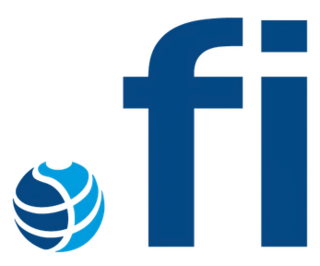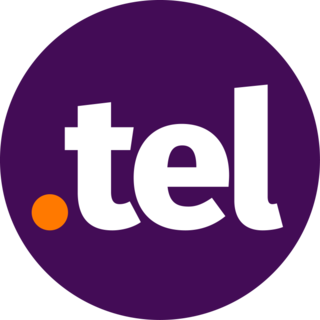The Domain Name System (DNS) is a hierarchical and distributed naming system for computers, services, and other resources in the Internet or other Internet Protocol (IP) networks. It associates various information with domain names assigned to each of the associated entities. Most prominently, it translates readily memorized domain names to the numerical IP addresses needed for locating and identifying computer services and devices with the underlying network protocols. The Domain Name System has been an essential component of the functionality of the Internet since 1985.
The DNS root zone is the top-level DNS zone in the hierarchical namespace of the Domain Name System (DNS) of the Internet.

The domain name .org is a generic top-level domain (gTLD) of the Domain Name System (DNS) used on the Internet. The name is truncated from 'organization'. It was one of the original domains established in 1985, and has been operated by the Public Interest Registry since 2003. The domain was originally "intended as the miscellaneous TLD for organizations that didn't fit anywhere else." It is commonly used by non-profit organizations, open-source projects, and communities, but is an open domain that can be used by anyone. The number of registered domains in .org has increased from fewer than one million in the 1990s, to ten million in 2012, and held steady between ten and eleven million since then.
Telephone number mapping is a system of unifying the international telephone number system of the public switched telephone network with the Internet addressing and identification name spaces. Internationally, telephone numbers are systematically organized by the E.164 standard, while the Internet uses the Domain Name System (DNS) for linking domain names to IP addresses and other resource information. Telephone number mapping systems provide facilities to determine applicable Internet communications servers responsible for servicing a given telephone number using DNS queries.
The Domain Name System Security Extensions (DNSSEC) are a suite of extension specifications by the Internet Engineering Task Force (IETF) for securing data exchanged in the Domain Name System (DNS) in Internet Protocol (IP) networks. The protocol provides cryptographic authentication of data, authenticated denial of existence, and data integrity, but not availability or confidentiality.
The Internet uses the Domain Name System (DNS) to associate numeric computer IP addresses with human-readable names. The top level of the domain name hierarchy, the DNS root, contains the top-level domains that appear as the suffixes of all Internet domain names. The most widely used DNS root is administered by the Internet Corporation for Assigned Names and Numbers (ICANN). In addition, several organizations operate alternative DNS roots, often referred to as alt roots. These alternative domain name systems operate their own root name servers and commonly administer their own specific name spaces consisting of custom top-level domains.

.fi is the Internet country code top-level domain (ccTLD) for Finland. It is operated by TRAFICOM, the Finnish Transport and Communications Agency.
A country code top-level domain (ccTLD) is an Internet top-level domain generally used or reserved for a country, sovereign state, or dependent territory identified with a country code. All ASCII ccTLD identifiers are two letters long, and all two-letter top-level domains are ccTLDs.
The domain name arpa is a top-level domain (TLD) in the Domain Name System (DNS) of the Internet. It is used predominantly for the management of technical network infrastructure. Prominent among such functions are the subdomains in-addr.arpa and ip6.arpa, which provide namespaces for reverse DNS lookup of IPv4 and IPv6 addresses, respectively.

The Naukowa i Akademicka Sieć Komputerowa or NASK is a Polish research and development organization and data networks operator.
DNS spoofing, also referred to as DNS cache poisoning, is a form of computer security hacking in which corrupt Domain Name System data is introduced into the DNS resolver's cache, causing the name server to return an incorrect result record, e.g. an IP address. This results in traffic being diverted to any computer that the attacker chooses.

The domain name .tel is a top-level domain (TLD) in the Domain Name System (DNS) of the Internet. It was approved by ICANN as a sponsored top-level domain, and is operated by Telnic. Telnic announced in January 2011 that over 300,000 domains had been registered since the start of general availability on 24 March 2009. A substantial drop of mostly IDN .tels occurred at the beginning of 2014. The total number of registered websites under .tel as of 9 October 2023 is approximately 43,227.
This article presents a comparison of the features, platform support, and packaging of many independent implementations of Domain Name System (DNS) name server software.
Google Public DNS is a Domain Name System (DNS) service offered to Internet users worldwide by Google. It functions as a recursive name server. Google Public DNS was announced on December 3, 2009, in an effort described as "making the web faster and more secure." As of 2018, it is the largest public DNS service in the world, handling over a trillion queries per day. Google Public DNS is not related to Google Cloud DNS, which is a DNS hosting service.

Knot DNS is an open-source authoritative-only server for the Domain Name System. It was created from scratch and is actively developed by CZ.NIC, the .CZ domain registry. The purpose of this project is to supply an alternative open-source implementation of an authoritative DNS server suitable for TLD operators to increase overall security, stability and resiliency of the Domain Name System. It is implemented as a multi-threaded daemon, using a number of programming techniques and data structures to make the server very fast, notably Read-copy-update or a special kind of a radix tree.
Namecoin is a cryptocurrency originally forked from bitcoin software. It uses proof-of-work algorithm. Like bitcoin, it is limited to 21 million.

Turris Omnia started as a crowdfunded open-source SOHO network router developed by the CZ.NIC association.
A public recursive name server is a name server service that networked computers may use to query the Domain Name System (DNS), the decentralized Internet naming system, in place of name servers operated by the local Internet service provider (ISP) to which the devices are connected. Reasons for using these services include:

OpenNIC is a user-owned and -controlled top-level Network Information Center that offers a non-national alternative to traditional top-level domain (TLD) registries such as ICANN. As of January 2017, OpenNIC recognizes and peers all existing ICANN TLDs, for compatibility reasons. However, OpenNIC has not yet evaluated and does not hold a formal position on future ICANN TLDs.








